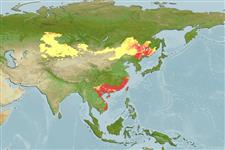Classification / Names
Common names from other countries
Main reference
Size / Weight / Age
Max length : 150 cm TL male/unsexed; (Ref. 30578); common length : 10.7 cm SL male/unsexed; (Ref. 35840); max. published weight: 45.0 kg (Ref. 7248); max. reported age: 21 years (Ref. 48)
Length at first maturity
Lm ?, range 58 - 79.2 cm
Environment
Freshwater; demersal; potamodromous (Ref. 51243); depth range 0 - 30 m (Ref. 6898)
Climate / Range
Subtropical; ? - 35°C (Ref. 52059), preferred ?; 65°N - 25°N
Distribution
Asia: China to eastern Siberia (Amur River system, Ref. 1441). Widely transported around the world (Ref. 7248). Persists only in Europe by stocking (Ref. 59043). Introductions often brought with it the parasitic tapeworm Bothriocephalus opsarichthydis (synonym of B. acheilognathi) (Ref. 12217). Several countries report adverse ecological impact after introduction.
Countries | FAO areas | Ecosystems | Occurrences | Introductions
Short description
Dorsal
spines
(total): 3;
Dorsal
soft rays
(total): 7-8;
Anal
spines: 3;
Anal
soft rays: 7 - 11. No barbels. Snout very short, its length less than or equal to eye diameter. Postorbital length more than half head length (Ref. 4967). 18 soft rays for caudal fin (Ref. 40476). Diagnosed from rather similar species Mylopharyngodon piceus by having the following characters: body olive to brassy green above, silvery white to yellow below; body cylindrical; pharyngeal teeth laterally compressed, serrated, with a groove along grinding surface, usually in two rows, 2,5-4,2 (Ref. 59043).
IUCN Red List Status (Ref. 115185)
Threat to humans
Potential pest
Human uses
Fisheries: minor commercial; aquaculture: commercial; gamefish: yes
Tools
Special reports
Download XML
Internet sources
Estimates of some properties based on models
Phylogenetic diversity index
PD50 = 1.0000 many relatives (e.g. carps) 0.5 - 2.0 few relatives (e.g. lungfishes)
Trophic Level
2.0 ±0.00 se; Based on food items.
Resilience
Low, minimum population doubling time 4.5 - 14 years (K=0.13-0.19; tm=2-10; tmax=21; Fec=50,000)
Vulnerability
High to very high vulnerability (65 of 100)
Price category
